 reviews
reviews
 Byrta | Byrta - Byrta (2013, Tutl) BYRTA is a new duo from The Faroe Islands with members Guðrið Hansdóttir and Janus Rasmussen. Guðrið is best know as a singer-songwriter and Janus is best known for his role in Icelandic electro band Bloodgroup. They met while they were both living in Reykjavík, Iceland and they started experimenting with electronic pop music. The result was the band BYRTA and a brand new album filled with catchy pop melodies. The first single ”Loyndarmál” became a massive hit on the Faroes Radio and on the dancefloors. All the songs on the album are in Faroese and are mainly about difficult relationships and isolated life on small islands in the middle of the Atlantic Ocean. (source: www.tutl.com) (Roger Rey) |
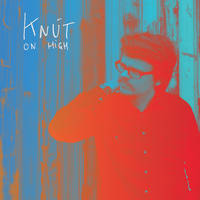 Eysturstein Knút Háberg | Eysturstein Knút Háberg - on High (2013, Tutl) Knút (full name; Knút Háberg Eysturstein) sings, plays instruments & writes songs. A native of the Faroe Islands, he currently lives in Copenhagen, Denmark. Knút's third album On High is underway with singles "The Road" & “Growing Old” out now. The songwriting is guitar and piano based, and in keeping with the conviction that the most interesting music is made from the melding of different inputs, Knút draws inspiration from a wide variety of styles and genres. His upcoming album will feature a collection of brand new songs with touches of 70's americana and gospel. The album is produced by Jens L. Thomsen (Orka, Eivør etc.) and was mainly recorded in the living room of Knút's and his sister’s old house in the middle of Tórshavn, Faroe Islands. The house where their grandparents and their mother used to live and were Knút has written many of his songs. “To me, music has always been about transcendence and survival”, Knút says. “Not in terms of food and drink survival, but a survival of the soul. It’s always been my way out.” And out he goes, bringing his brand new album with him across the ocean and on the road. Going way back, fast forward. (source: www.tutl.com) (Roger Rey) |
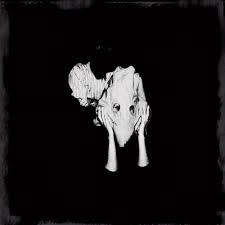 Sigur Rós | Sigur Rós - Kveikur (2013, ) Kveikur - the new album from Sigur Rós - was released on June 17th / 18th 2013, and is capturing imaginations worldwide with its dark, powerful sound. The album, which was available to be streamed on Amazon a week before its official release, is the group's seventh studio release. It is the first not to include erstwhile member Kjartan Sveinsson, who left last year, and also signals a new era in terms of sound: the band themselves hinted the new record would boast a "more aggressive" sound than their previous works, and the album does indeed boast a quality that is earth-rumblingly heavy and compelling. (source: www.imx.is) (Roger Rey) |
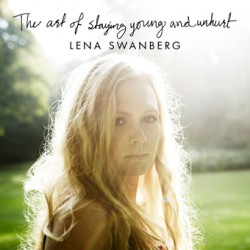 Swanberg Lena | Swanberg Lena - The Art Of Staying Young And Unhurt (2012, Diesel Music) Lena Swanberg's musical background is founded in jazz yet her debut album also spans a suggestive borderline between dramatic pop and singer-songwriter writer styles that fill ones ears with fresh sound. Her debut album is produced by Göran Petersson (Sofia Karlsson, Jeanette Lindström among others). Some harmonies lean towards pop music and others towards jazz and blues. Sometimes, there is a subtle mystic that is reminiscent of how Nina Simone could have sounded if she was a 29 years old Swede. Christian Kjellvander who is one of Sweden's most respected singer-songwriters records a duet with Lena on the album as well. Lena Swanberg grew up in a small idyllic village in the Swedish county of Hälsingland. However, a big portion of her childhood was spent living in Saudi Arabia, United Arab Emirates and Kenya. From the middle of her teenage years, their followed a dark period in Lena's life. "Within the fight of understanding yourself, you meet alot of demons", Lena said. "There was not enough space for what was beautiful and good alone. All the rest was forced to make space for all the feelings that I felt". The turning point come when Lena travelled to Brazil and found what was to be her path of life. There she was met with a culture full of color, warmth and excitement. "Everything that is beautiful was cherished and the rest you just ignored completely”, Lena said. It was also here that she began to question much of the way she had learned and approached music and the pre-defined relationship towards creating it. ”My own voice and music has always been there inside me waiting to find its way into the open. When I finally found my own expression then I was able to feel consolation. If my music can console someone more than myself then the feeling is even better", Lena said. source: playground (Roger Rey) |
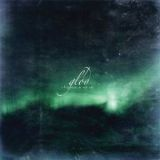 Glóð | Glóð - Mítt Stríð Er Mítt Ríki (2012, Tutl) Based on the urge to make great songs, different than ever heard before on the Faroe Islands, glóð, was formed in 2009. Four young men with an outside view on the faroese community and hope for change, began creating songs for an album. After two years and a lot of hard work in Kris-Stuff Studio, they are now ready for the release of their debut album “Mítt stríð er mítt ríki”. All the lyrics are in faroese, and the music can be described as melodic and atmospheric alternative rock with a twist of electro-pop. (Roger Rey) |
 Benjamin | Benjamin - Ghost with Skin (2011, Tutl) Benjamin's music is very complete. It's as simple as it is diverse, it is as raw as it is pretty, as beautiful as is it scarred and as unsettling as it is sweet. Benjamin weaves a lot of fabric into the whole and it feels natural as Benjamin is naturally gifted, like an awakening in a dark room, as he evokes ghosts within the skin that become one with the bloodstream that keeps us alive. Benjamin's music is heartfelt and true. (Roger Rey) |
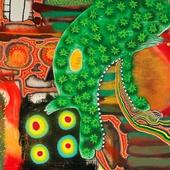 Hjálmar | Hjálmar - IV (2009, Borgin Records) It's summer now. You want to try to listen to something new? What about Reggae-Music from Iceland? check out: http://www.myspace.com/hjalmarmusic (Roger Rey) |
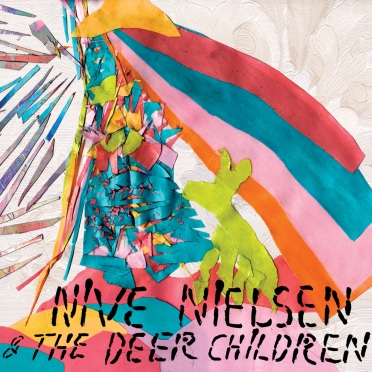 Nielsen Nive | Nielsen Nive - Nive sings (2012, Glitterhouse) Wonderful debut album from the girl from Nuuk (Greenland) featuring musicians like Howe Gelb John Parish and Angu Motzfeld. Don't miss to see her live on stage at the St. Gallen Openair-Festival on Sunday 27. June at 11.30 a.m!!! (Roger Rey) |
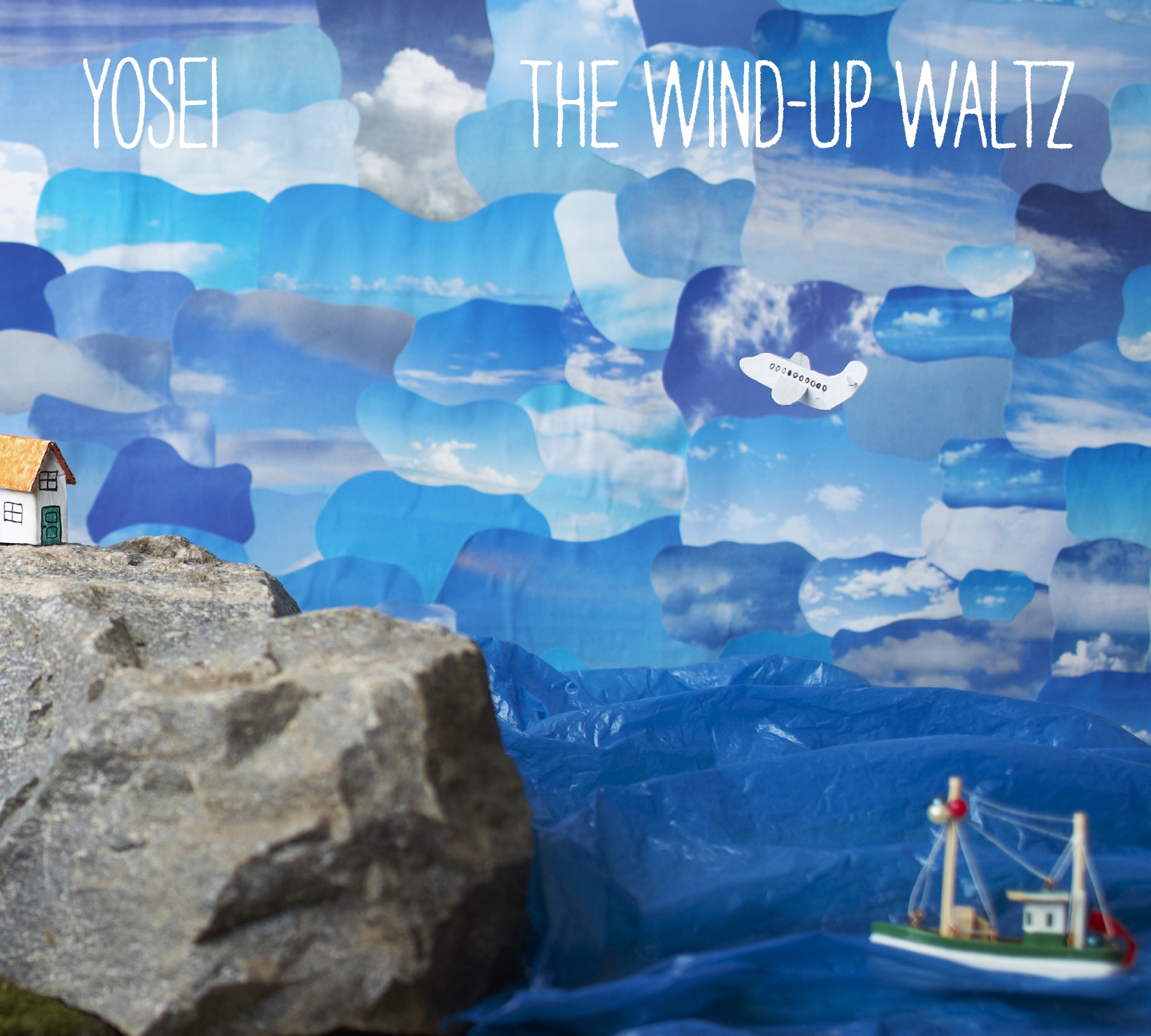 Yosei | Yosei - The Wind-Up Waltz (2010, Brus & Knaster/Playground Music) Meet Yosei – a band with a feel and flair for expressionism, that with their finely tuned instrumentarium creates an urbane brand of folk-pop with a touch of jazz. The new album The Wind-Up Waltz comprises a set of beautifully shimmering songs, inspired by singer/sax-player Lina Langendorf’s insightful travels around the globe, clearly indicating that the band’s name, a Japanese word meaning fairy is aptly chosen. The new album was recorded in Svenska Grammofonstudion in Gothenburg and mixed by August Wanngren (Wildbirds & Peacedrums etc). (source: Playground Music) (Roger Rey) |
 Jónsi & Alex | Jónsi & Alex - Riceboy Sleeps (2009, Parlophone) riceboy sleeps is an artistic collaboration between jon por birgisson (singer for sigur ros) and his boyfriend alex somers. they create visual art as well as this stunning music on their inspired and emotional debut album. the first track heard outside iceland was 'happiness' - the standout cut on 'the dark was the night' charity compilation album produced by aaron and bryce dessner of the national. 'happiness' sets the listener up for the next hour of listening by hypnotising and smothering your ears with yawning strings that grow and shrink in tone and volume. each track twinkles, shines, shimmers and stretches out for miles at a time. you really need to look underneath the sparsity and into the atmospherics the record creates. choir like vocals interlace with harmonic guitar feed-back as the faintest of white-noise rises in the background. it transforms the instruments into imaginative tools of creationism that work slowly but professionally, carving the majestic beauty that is this record. (source: Rough Trade) (Roger Rey) |
 Lisberg Høgni | Lisberg Høgni - hare! hare! (2008, Tutl) Now released: the new Høgni Lisberg CD \"hare! hare!\" His first Solo-Album „Most Beautiful Things“ (2003) has been a quiet, intimate and atmospheric singer/songwriter-album, which was a big promise for the future of this young musician. In 2005 he released „Morning Dew“. The album was more pop music orientated and a first big challenge to get a new audience. In his live shows, Høgni proved to be a great performer and entertainer. Now, 2008. The young faroese guy, has been growing up and he’s living with his family in Copenhagen. And that’s how „hare! Hare!“ sounds. Modern funky-pop-songs, which sometimes remember to Ben Harper or Lenny Kravitz. So it’s not a big surprise that he could show his entertaining talent as supporting act for Paolo Nutini or Badly Drawn Boy. (Roger Rey) |
 Judge Bone | Judge Bone - Big Bear\'s Gate (2008, Bone Voyage) Rough and raw - Americana and Blues from the perspective of the Finish R'n'R Shaman. It's a bit like having a bottle of bourbon, while sitting in a countryside sauna shack on full steam, but just on the first sight. Because this here is all about beauty and truth, deepness, nature and love. Tuomari Nurmio aka Judge Bone is a legend of Finish Rock'n'Roll, one of the true Finnish originals. With his former finish language albums of broad musical variety, he has established himself as one of the most original Finnish singer-songwriters. His lyrics are filled with peculiar and arresting metaphors and expressions, some of which have made their way into the vernacular Finnish language. Big Bear's Gate is his english sung debut for Bone Voyage and for the world outside of Finland. Tuomari Nurmio actually holds a University degree in law, which would allow him to work as a judge. But he quit for the music and got his nickname Tuomari, which in finish means "judge". If not playing on his own he plays with his drummer Markku Hillilä, who's profession is a doctor. So this makes Judge Bone & Doc Hill. (source: Bone Voyage Records) (Roger Rey) |
 Tiamat | Tiamat - Amanethes (2008, Nuclear Blast) “Amanethes” is a greek-turkish word, describing a kind of a very slow song, eastern-oriented, which usually contains the word “Aman” many times, which could be translated as “show some understanding” or it declares “pain” and “sadness”. Beyond that “Amanethes” have a unique musical pattern, which dresses the notes and surrounds the sadness of lyrics. Anyway, what TIAMAT portray here, has little to do musically with the classic amanethes in music. To be honest, metaphorically there are many similarities of the general concept to what amanethes really are, but this is another discussion… TIAMAT are different here… Very different, so do not expect another “Prey” or another “Deeper Kind Of Slumber” or “another “Wildhoney”. In general, do not expect to categorize this attempt under a single TIAMAT musical period. There are many classical TIAMAT elements throughout this album, taken from all the periods of the band, as also new elements, first time appointed by the band. Of course, the music is still Gothic metal, however dressed with many different musical ideas. Being a band with a constant developing style, they succeed in an innovative new style and obtained a new sound here. For instance, their sound is heavier than it used to be, more powerful bringing to mind bands such as “The Vision Bleak” or “Samael” at some tracks. Furthermore, Johan’s vocals are different. They changed to a darker and harsher way, in order to fit to the musical changes. Personally, I preferred Johan’s vocal style of the past… Taking a closer look to the album itself, one thing is for sure, TIAMAT are back for good. All tracks have a dark mood, as also the controversial TIAMAT lyrics, as being presented throughout all these years. A representative sample of what “Amanethes” is about is the beautiful cover artwork… The more you listen to it, the more you come across some ideas you didn’t notice before. I should not say it is a difficult album to listen and understand, however it has some hidden musical treasures, which need extensive listening to be enjoyed. “Until The Hellhounds Sleep Again”, “Misantropolis”, “Katarraktis Apo Aima” and “Amanes” are some of the favorite moments of the album, with almost all the other tracks being of the same quality. “Amanethes” was produced by Johan Edlund himself and the recordings took place mainly in Greece’s “The Mansion” and “Cue” studios. The album was mixed and mastered in Germany’s Woodhouse Studios by Siggi Bemm, in January of 2008. Concluding, TIAMAT issued an impressively mature album, innovative enough to attract new fans and conservative enough to satisfy their older ones. (source: www.metal-invader.com) (Anita Steck) |
 Disco Ensemble | Disco Ensemble - Magic Recoveries (2008, Vertigo) In the spring of 2008 Disco Ensemble release their third full-length album titled "Magic Recoveries". Produced by Pelle Gunnerfeldt (The Hives, Refused, The Robocop Kraus), the record shows the band flourishing, stretching their abilities as song writers and performers. Finding a perfect balance between fury and grace, "Magic Recoveries" is a confident assortment of innovative rock'n'roll, celebrating primal inspiration as the ultimate outlet in a confusing world. (source: www.fullsteamrecords.com) (Anita Steck) |
 Animal Alpha | Animal Alpha - You pay for the whole Seat, but... (2008, Racing Junior) So they're back! Perhaps the best rock band ever to come from Norway, at least Animal Alpha are competing with TNT, Vagabond and Audrey Horne at the throne. I couldn't hold back my excitement over their debut album "Pheromones" (2005) and this groundbreaking band does not disappoint with their new album "You pay for the whole seat but you'll only need the edge". The surprise moment is gone with the new album since I know now what to expect from this odd and crazy band, but the songs will still knock you to the ground like a buffalo stampede. Animal Alpha are fun to listen to, they're like a roller coaster ride at the amusement park or a Quentin Tarantino movie with a smart dialogue and plenty of action. This band rock with the same energy as The Who in their youth years and with the same attitude as Sex Pistols on their historical "Never mind the bullocks". I should be more than pleased with songs like "Pin you all", "Fire, fire, fire" (explosive as fireworks), the mega heavy "Breed again" and the awesome "Master of disguise" but 8 songs aren't enough, I want more and do hope they won't wait another 3 years til the next album. Absolutely fucking fantastic (source: www.melodic.net) (Anita Steck) |
 Madrugada | Madrugada - Madrugada (2008, ab Import) Guitarist Robert Burås left this world much too soon. And he will be missed. Those of us that got to see Madrugada live can certify that he was a main character in this otherwise so well put together combo. Being the sixth and final album from Norway's finest, this is nothing but pure genius. The intensity is evident throughout, both musically and vocally. On this self-titled full-length, the band has taken the atmosphere of foreboding that is their trademark to a higher level, which leaves us, the listeners, in a state of darkness that's indefensible. Simply put, we're reeled right in and I wouldn't want anything else. Frontman Sivert Høyem sings with such authority and grace, it makes my eyes fill up with tears. Sivert has a hypnotizing way of taking each song to perfection. "The hour of the wolf" is a straight-forward rock song with howling guitars, powerful drums and a showcase of one of the shapes that was Madrugada. It's rock'n'roll in its purest form. The more acoustic "Look away Lucifer" is a dark and eerie song that sort of sums up the album as a whole. The uncanny feeling of this swan song is charming in a way that you never want to end. But, all good things must come to an end and I can't think of a better way than this. (source: www.itsatrap.com) (Anita Steck) |
 Dico Tina | Dico Tina - Count to ten (2008, Universal) TINA Dico first grabbed the attention when she teamed up with Zero 7 for tracks like Home. The Danish singer-songwriter now releases a new album, Count To Ten and continues to impress. The follow-up to her critically-acclaimed In The Red, it’s a strong collection of emotive songs that make good use of her soft, yet powerful voice and which draws on influences such as Donovan, Radiohead and Leonard Cohen. The quality is evident from the beginning, when title track Count To Ten beguiles listeners with its understated mix of melancholy vocals and violin and cello. But it gets better with On The Run, a gutsier blend of folk and country that finds Dico’s vocals at their most forceful. The brash electric guitar interludes are a nice change of pace, too, and compare well with KT Tunstall’s use of them. In truth, the following three tracks – Open Wide, Night Cab and You Know Better – fail to command as much immediacy or attention. But just when the album threatens to get caught in the mundane, Dico delivers Sacre Coeur, an imagery-laden gem that’s passionately delivered (sometimes heartbreakingly so) and bolstered by a terrific chorus. It’s arguably the album highlight and further impresses with its guitars and piano chords. Craftsmanship And Poetry, the track that immediately follows, is another strong piece of songwriting – softer, more tender and vocally reminiscent of Sheryl Crow in places. But it enchants with ease. My Business then raises the vibe once more and again benefits from some intricate guitar loops, and final track Everybody Knows draws things to a beautiful close. Dico has already won a Best Songwriter Grammy and best composer at the Danish Music Critics’ Awards and further accolades could well follow for some of the songs on this LP. If you were smitten with her style as part of Zero 7, then maybe now’s the time to pick up a serious relationship with her as a solo artist. You won’t be disappointed. (source: www.indielondon.co.uk) (Anita Steck) |
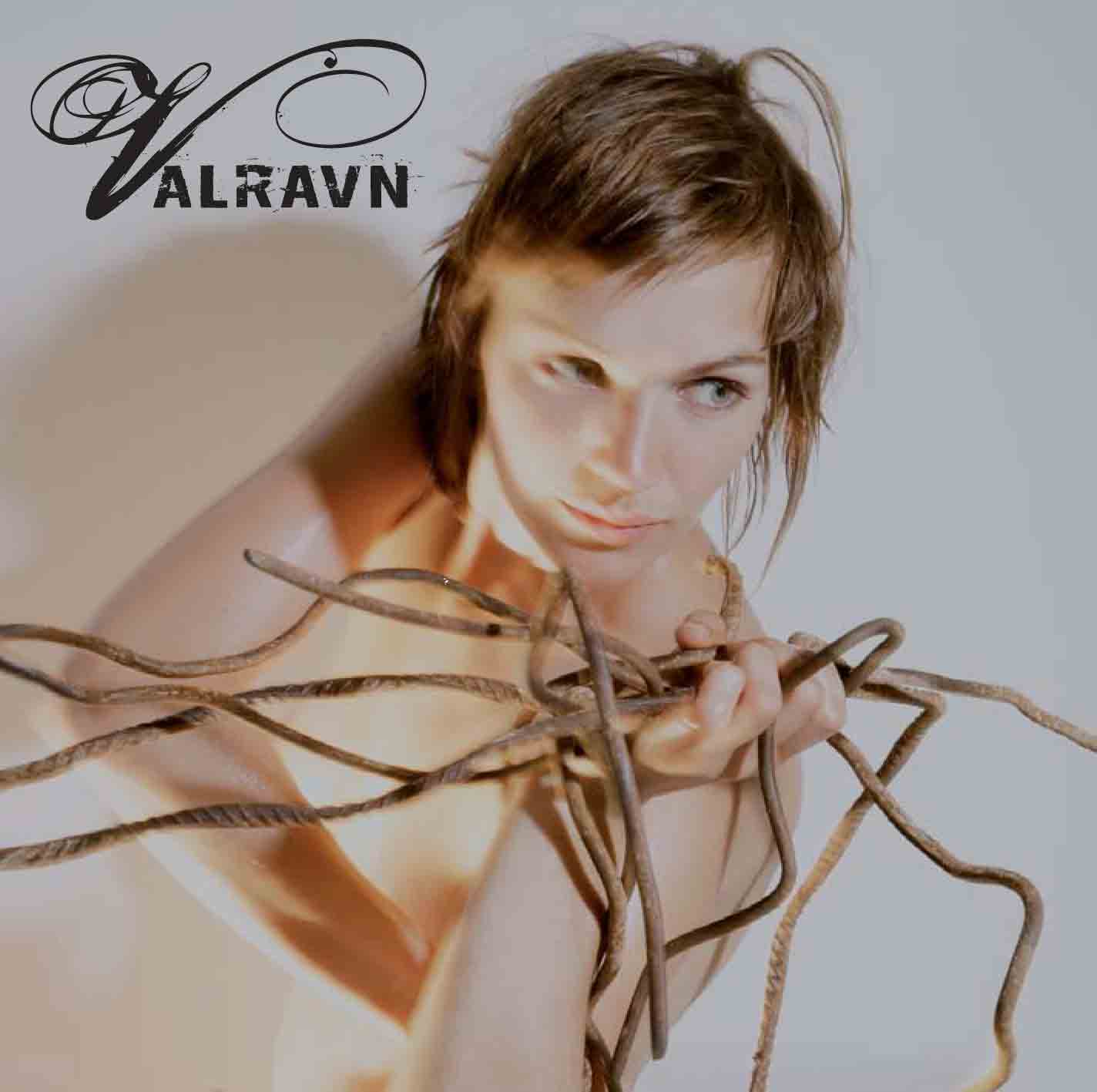 Valravn | Valravn - Valravn (2007, Gateway Music) At least it’s done. After the EP “Krunk” from the year 2005, the Danish electro-folk band Valravn released their first long-playing album. Beside their own songs, Valravn took up traditional Danish, Icelandic, Swedish and Faeroese subjects and arranged them very infectious and modern. Typical Celtic instruments were skilful added with modern electronic elements. Tradition goes hand in hand with modernity. Influences of Gåte, Garmarna or Hedningarna are unmistakable. The voice of the Faeroese Singer Anna Katrin Egilstrød remembers partly to Björk, Emiliana Torrini or Eivør Pálsdóttir – sometimes powerful, sometimes soft. The listener is invited to go to a imaginary trip to the land of trolls and fairies – magical but native and real. Valravn have been creating a great and style overlapping album, which will be accepted enthusiastically by lovers of traditional music as far as rock music fans. (Anita Steck) |
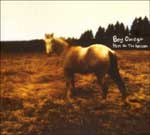 Boy Omega | Boy Omega - Hope On The Horizon (2007, Glitterhouse) On “Hope on the Horizon”, Boy Omega (Martin Henrik Gustafsson) follows up his critically acclaimed 2006-albums “The Black Tango” and “The Grey Rainbow”, with yet another impressive collection of songs that showcase the growth of his songwriting. As always when you hear a new Boy Omega-record, there’s something new going on. This time it’s a lot less electronic than before. This is something warm and analog, featuring big walls of strings, horns, acoustic pianos etc. It sounds like dogma 95 movies look like: authentic, melancholic and drenched with the bitter beauty of life. It’s more of a “band album” than a “solo album”. It features no less than 12 other people playing and singing along with Martin. Except for the regular core-members of the Boy Omega Orchestra (Per-Ola Eriksson, Karin Wiberg and Andreas Lassus), members from other swedish bands such as Tiger Lou, Audrey and Irene also contributed. The album was recorded over the last two years at various locations in Göteborg, Sweden (mainly Kepner Treg Studios and Musikens Hus), in between tours, other recordings and day-to-day life. It was engineered by Per-Ola Eriksson and produced by everyone involved. The band had been trying out most of the songs live before the recordings started, and since they worked very well that way, they decided to record as much as possible live in the studio, and use first or second takes. “During this period of time I listened a lot to the Van Morrisson-album “Veedon Fleece”, Bob Dylan’s “Blonde on blonde”, Nicolai Dunger’s “Soul rush”, Håkan Hellström’s “Ett kolikbarns bekännelser”, the selftitled Broken Social Scene-album and last but not least, a huge pile of Phil Spector and his “wall of sound”-productions. Those albums were an influence in the recording process. “More is more” kind of became the catch phrase in the studio”, Martin says. The songs are about them black eyes, the hidden signs, pulling the plug, pulling down your pants, childhood summer memories, animals, alarms, auras, traps, targets, cocoons, buckets of friendship, acts of revenge, threats, bulletproof vests, fire, explosives and their related effects, warm city lights, tram #9, body power, wrongdoings, drinking yourself off the map, fixing a broken heart, dissociation, roofs falling in, far distances, tall grass, sleeping pills, coping mechanisms, late night phonecalls, bent rules, biting kisses, the rising sun and hope on the horizon. Martin’s voice is the hook. In the past, reviewers have mentioned it alongside Robert Smith (The Cure), Elliott Smith, Win Butler (Arcade Fire), Conor Oberst (Bright Eyes), Will Oldham, Sam Beam (Iron & Wine), Kristofer Åström (Fireside/Hidden Truck) etc. So even if it may be reminiscent of many, it’s without a doubt uniquely his own. Besides from recording “Hope...”, releasing two albums, a tour-cd (feat. 15 rare tracks and covers), two singles, the split cd “If we were oceans” (w/ Kristofer Åström, Racingpaperplanes and Two Times The Trauma) and appearing on the Magnetic Fields tribute cd “Our love is meaningless”, Boy Omega also managed to play more than 60 shows in 2006. Germany, Austria, The Netherlands and the UK were frequently visited. In the summer they played the Reeperbahn Festival in Hamburg, The End of the road festival in the UK along with artists such as Ryan Adams, Ed Harcourt and Badly Drawn Boy. They also did shows together with Isobel Campbell, Akron/Family, The Hidden Cameras and Jason Collett. This year Boy Omega joined Saddle Creek recording artist Maria Taylor on a 34-day tour through Europe. Martin played 19 of the shows solo and 10 with the band. Germany, Austria, Italy, Croatia, the UK and Scandinavia were visited. This is the next step in the impressive career of Boy Omega. Martin and his friends have created something beautiful and timeless together. In a sea of imposters, Boy Omega is the real deal. (source: www.glitterhouse.de) (Anita Steck) |
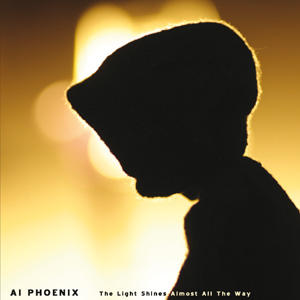 Ai Phoenix | Ai Phoenix - The Light Shines Almost All the Way (2007, Glitterhouse) Ai Phoenix’ fifth album ‘The Light Shines Almost All The Way’, will be released by Glitterhouse Records the 15th of June 2007. The album has been recorded in a house southwest of Bergen, Norway. During three weekends the band gathered a few friends and recorded a lot of songs. As often before the band later on spent a long time working on details and alternative ideas. The songs have characteristic mixes of supposed contradictions like joyfulness and sorrow, optimism and melancholia, sensitivity and clumsiness, integrity and doubt. It is a complexity that you would find in books like Hotel New Hampshire by John Irving, or the films of Charlie Chaplin. The band itself has always referred to friends, events, films and books, as well as music when asked about influences. As Keith Jarrett once tried to explain: ‘Music is a result of a project that has nothing to do with music’. Most of all there is a relaxed rather than insistent sincerity in all of Ai Phoenix’ albums. This is not a band that would ask you to listen and feel. You might pass by, you may be happy or sad, and you may dance. (source: www.glitterhouse.de) (Anita Steck) |
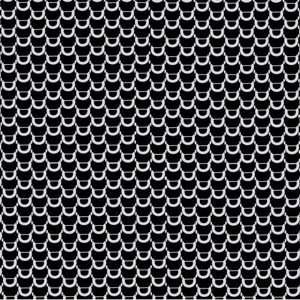 Dungen | Dungen - Tio Bitar (2007, Subliminal) Dungen took longer to catch on than your average overnight sensation. In 2004, momentarily existing outside the micro-managed Web 2.0 landscape, the band shouted a hearty Swedish "surprise" with their excellent Ta Det Lugnt. It may have been the language barrier-- or the fact that the collection was released by Subliminal Sounds, a smallish Stockholm-based label known as much for its exotica/cocktail bent as for its underground psych fetish-- but the group seemed to come out of nowhere, with little advance word or ground-level buzz. Of course, we're talking stateside reception. At home in Sweden, they'd already undergone a post-major label backlash (and, after flourishing elsewhere, a sheepish critical rebirth). Since those days of relative anonymity, though, Dungen have toured extensively as a four-piece, reissued and reconfigured older material, and connected with the New York-based Kemado label, who in 2005 issued a super-sized Ta Det Lugnt. Despite the flurry, Dungen's reputation still rests on that one gem of a record in its original, slimmer state: The early material wasn't that great, and the extras included on the deluxe edition felt gratuitous. Now, three years after that album's first release, Dungen has issued Tio Bitar, album number four. Worth the wait? Well, bad news first: There's no "Panda". But then, it's a different, imperfect monster: Tio Bitar explores the mellower side of psychedelia, working largely as the dusk-backdropped counterpoint to the band's earlier fireworks. Dungen mastermind Gustav Ejstes has spent the past few years studying fiddle with a Swedish master, and while it adds another distinctive layer to the group's distinguished sound, its omnipresence lends the album a decidedly different feel. Perhaps the album's strangest attribute, though, is how even a few of the best songs here-- excluding, of course, tracks like "Gör Det Nu" or "Du Ska Inte Tro Att Det Ordnar Sig", on which the band unequivocally succeeds-- come off as something gorgeous in the background, rather than the in-your-hair, fist-pumping rockers Dungen seems to have intended. The record opens extraordinarily with "Intro", a fried stage-setting rocker that massages one of guitarist Reine Fiske's majestically distended, havoc-wreaking guitar lines (and extended chords) through repeating flutes and busybody drums. As counterpoint, the next track, "Familj", is pleasantly airy, an afternoon Dungen pastoral that could go on forever. Then, the band summons stormclouds with the blustery, thundering "Gör Det Nu", echoing "Intro" in sheer fret magick, and shredding off any remembrance of its golden-skied predecessor. But, perhaps acknowledged by its title (Tio Bitar translates as "10 Pieces"), the album doesn't always congeal. One song may uncharacteristically plod while the next overreaches. Most of its tracks are brief-- six clock in under four minutes, one above eight-- but while the tracks weren't much longer on Ta Det Lugnt, they all felt titanic. Granted, Tio Bitar's aesthetic pull aims for somewhat different horizons than the last album's larger, more energized sound, but-- tough love, guys, tough love-- where even Ta Da Lugnt's verdant instrumentals hooked talons into you, a few of these suites slide past like water off a duck's back. Instrumentally, of course, the album is airtight. Its loose, colorful sunbursts of bright fiddle, guitar, organs, drums, tambourines, and flute find the band perhaps at their most technically proficient to date. In promotional material, we're reminded Dungen is basically the omni-instrumental Ejstes accompanied by guitar ace Reine Fiske, and here, Fiske's leads are the stars: Despite the band's overall move toward a quieter gentleness, his guitars cook with a unrestrained, Hendrixian sizzle. The drums, too, have their colossal moments-- especially when twisting out seismic rolls on "Svart Är Himlen". (Who's the more fun multi-instrumental drummer, Mascis or Ejstes?) Still, chops alone can't salvage the midtempo "Ett Skäl Att Trivas", which sounds and feels like Dungen, but, with its lifeless drums and soporific bassline, bores very much unlike Dungen. Or, the one gigantic track, "Mon Amour", which recedes into extended soloing, forgoing the band's usual, admirable restraint for the kind of hippie self-indulgence they've always managed to transcend. Even given these disappointments, though, the record is far from a dramatic departure from the band's previous outings-- you'd certainly never mistake it for another band-- and its few missteps are well balanced by a handful of blissful, seismic bright pockets. Just be ready for its late-afternoon haze: Leave your acid on the porch and grab the bong instead (Source:www.pitchforkmedia.com) (Roger Rey) |
 Eivør Pálsdóttir | Eivør Pálsdóttir - Human Child (2007, Tutl) Two albums of the Faeroese singer Eivør Pálsdóttir have been released in July 2007. “Human Child” and the Faeroese version of the album “Mannabarn”. Both albums have been recorded in Ireland with Irish musicians. You can hear the Irish influence when you’re listening to the album. But “Human Child” and “Manabarn” are more pop than folk or jazz. Eivør Pálsdóttir proves once again that she has a beautiful and unique voice. The last song is dedicated to her younger sisters Elisabet and Elinborg. They’re singing together with Eivør the refrain of the song. It seems that the young Faeroese singer has not found her Genre yet. Every new album is full of surprises. You can never say in advance which genre it will be. Once it is jazz, then traditional, sometimes rock music or avantgarde – and on the both new releases you can try to put it in the genre pop. It’s not possible to categorize. What will be the next album? Well, we’ll see... (Anita Steck) |
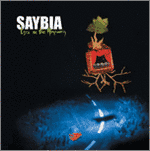 Saybia | Saybia - Eyes on the highway (2007, EMI) Now it’s done – the third album of the Danish band Saybia has been released. Since their debut album “The second you sleep” Saybia got more and more known also outside of Denmark and Scandinavia. One reason for that is of course their big success as a great supporting act of A-Ha. The new album “Eyes on the highway” contains among the typical ballads also some rock music. The songs “Godspeed into the Future”, the title track “Eyes on the Highway” and “Romeo” have hit potential. “Romeo” remembers on their Norwegian friends of A-Ha. Once more, Saybia prove that they can write and arrange great songs. Recommendations: - Godspeed into the Future - Eyes on the Highway - Romeo - Gypsy - A way out (Anita Steck) |
 Biggi | Biggi - id (2006, 12tonar) He's been the singer/guitarist of Icelandic indie rock band Maus for quite some time now. Everyone calls him Biggi, and you’re welcome to do so as well. He moved from his hometown of Reykjavik, Iceland, to London late 2004, to focus on his creative work after it was apparent that Maus where to go on an indefinite hiatus. The album was produced by Bomb the Bass’ Tim Simenon with co-producer Geoff Smith (of Frozen Flames), and mostly recorded by Biggi himself here and there around Reykjavik and London. Id is a personal, creative and always an interesting pop album – that shows that Biggi has good control over his electronic/pop creations. (source: www.12tonar.is) (Roger Rey) |
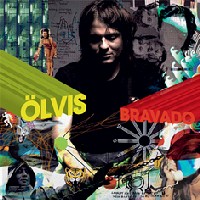 Olvis | Olvis - Bravado (2007, Resonant) and drums on three tracks from APPARAT ORGAN QUARTET's Arnar Geir Omarsson and violin from Maria Huld Markan Sigfusdottir from AMINA (Sigur Ros' string quartet) on one track. The whole album was written and produced by Orlygsson himself, and was recorded mainly at Sigur Ros' Sundlaugin studio during the fall of 2005, and lyrically touches upon Orlygur's disillusionment with global capitalism and US hegemony - not that you'd know it, unless you speak Icelandic... (source: myspace) (Roger Rey) |
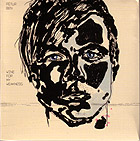 Ben Pétur | Ben Pétur - Wine for my Weakness (2006, 12Tónar) First solo album from Petur Ben, the guitarist, singer songwriter and co-worker of Mugison for many years. Totally self-confidence and matured, beautiful album reminding slightly of Radiohead, David Bowie and Nick Cave. (source: www.smekkleysa.net) (Roger Rey) |
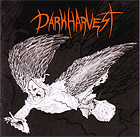 Dark Harvest | Dark Harvest - Dark Harvest (2006, Smekkleysa) A massive album of instrumental metal from trio Dark Harvest, which is lead by the unbelievable guitar talent of Gudlaugur Falk. (source:www.smekkleysa.net) (Roger Rey) |
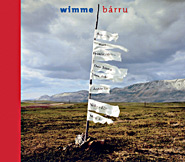 Wimme | Wimme - Barru (2002, Rockadillo) Bárru is Wimme's 4th release, and it is as astonishing as the previous three. Surprises lurk around every corner, as does a constant sense of playfulness. Using electronics, an array of plucked string instruments, various sound effects, and most of all, his astonishing range of sounds, Wimme and his band create a comprehensive and wholly unique listening experience. Hedningarna singers Tellu Turkku and Liisa Matveinen provide guest backup vocals. (source: www.noside.com) (Roger Rey) |
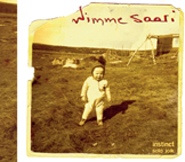 Wimme | Wimme - Gapmu (2004, Rockadillo) Gapmu provides a showcase for solo voice, a personal statement from Wimme Saari which demonstrates how joik touches all aspects of life. Listening to Wimme's voice conjures generations of his ancestors, an ancient sound channeling through a young body. Yet even when he's singing solo you feel a sense of perspective, wisdom and humor that comes from a man who is clearly living in the modern world. (source: www.noside.com) (Roger Rey) |
 Thunderbear | Thunderbear - Thunderbear (2006, Morningside Records) The album is instrumental music and has been said to be somewhere between French composer Erik Satie (among other things known for his "furnite music") and Canadian group Godspeed You Black Emperor (which in some ways also resemble Sigur Ros and Mogwai a bit). But what makes Thunderbear interesting and sets the music apart from the before-mentioned artists - and makes it distinctively Thorbjørn - is the pianoplaying which the other bands don't use at all or to the same extent. Sometimes simple slow moving pieces and other times as if the keys are caught in a whirlwind over the Sea of Japan or wherever. Breathy bass clarinet fondle chugging beats and electronic noises coughing in the background - and then slip off into infinity towards miles-high guitar-structures for a climax that makes the hairs stand up on your arms. It's not Under Byen. It's a personal slice of it, so to speak. Which of course makes sense because it's a part of Under Byen doing it. Still, this is uniquely Thunderbear. And it's a very rewarding journey indeed. (source: www.morningsiderecords.dk) (Roger Rey) |
 Alamaailman Vasarat | Alamaailman Vasarat - Käärmelautakunta (2003, Wolfgang Records) This one's easy: if you liked Vasaraasia, you'll like Käärmelautakunta. The overall method hasn't changed from the debut album to this, the sophomore effort - the music here is a melting pot of "ethnic" melodies played on mostly non-rock instrumentation (as before, cellos, trumpets, and saxes tend to dominate, with lots of pump organ in the background) in a rock context. But where Vasaraasia tended to flit between fast, jittery, up-tempo pieces and extremely dark and brooding ones, this one generally occupies a middle ground more often. Much of the album is still distinctly moody, with few tracks that are as upbeat as, say, "Mamelukki and Musta Leski" from the debut, but they don't tend to get as droney or depressing as some of the pieces from the earlier album. The last two tracks break away from this sort of mid-tempo, mid-mood theme, with "Lentävä Mato" being the most upbeat and energetic piece on the album and "Jää, Hyvä Mieli" the hardest-rocking. The latter especially is quite a departure, consisting almost entirely of an extremely slow, inexorably plodding heavy-metal riff (on cello, of course) overlaid by meandering pump organ and sax. Doom metal meets Eastern European folk: it's quite an experience... and it works. Aside from the above, it's tough to describe this album either in terms of its predecessor or on absolute terms. The moniker "ethnic brass punk" that the band trumpets on their website still seems to hold, but Käärmelautakunta doesn't seem quite as fresh in that sense as the debut, probably simply because it's really more of the same. In this case, though, I'm not complaining — this is really great, top-notch stuff, and though it doesn't break new ground as compared to Vasaraasia, I think it's more consistenly enjoyable as a whole, and it has become my favorite of two albums. And where else do you get to hear a dual-cello attack that really rocks? (source: www.progreviews.com) (Roger Rey) |
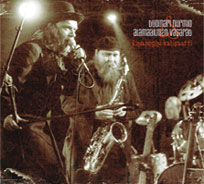 Alamaailman Vasarat | Alamaailman Vasarat - Kinaporin Kalifaatti (2005, Johannakustanus) Sometimes — rarely, but sometimes — the best description of a band comes from the band itself. "Alamaailman Vasarat is a Finnish group playing horny and punky secret agent brass music," claims this band's website, and for their first two albums, Vasaraasia and Käärmelautakunta, this amusing blurb is awfully accurate in a strange way. On this album, which sees the ethnic-brass-punk group (another of their own remarkably appropriate descriptions) collaborating with Finnish vocalist Tuomari Nurmio, the description doesn't fit quite as well. To my initial disappointment, many of the elements that made AV's first two albums so unique are gone. The long, slow dirges full of mournful cello and sinister pump organ are nowhere to be found. The heavy-metal cello playing, miked and amplified to sound like crunchy electric guitars, has also disappeared. Even the overall brooding and claustrophobic mood has pretty much been replaced by a more upbeat and almost traditionally jazzy vibe. Make no mistake, the instrumentation on this album is nearly precisely the same as on previous albums; the cello playing is still killer and the leads on saxes and trombone still catchy as hell, but the overall method of attack has changed significantly to more conventional approach. Though I know nothing about Scandinavian folk aside from the rockified stuff on labels like Northside, I imagine this new approach is somewhat closer to that tradition, while still borrowing from jazz and klezmer as well. Tuomari Nurmio adds a rock influence with his gravelly vocals — these take some getting used to, and sometimes I still find myself wishing for the deep and idiosyncratic voice of Höyry-kone's Topi Lehtipuu, but I've acclimated myself to them and have come to appreciate his admittedly fairly unique style. The vocals are omnipresent, though; this album is a 180 degree turn from AV's previous entirely instrumental efforts, with every song featuring Nurmio. "Riivattu" is a favorite of mine, featuring a jerky rhythm elaborated on guitar (a new instrument for the band, which Nurmio plays) overlaid by vaguely klezmerish horns, swooping cello, and a tuba bleating off and on around the beat. I also really like the more downtempo "Rypistynyt profeetta," with its juxtaposition of a jazzy groove and a pump organ drone. This neat combination gives out midway through to a section that borrows heavily from a generic Middle-Eastern vibe, particularly in the percussion, then goes all cinematic and, well, "secret agent" before returning to the original theme. Fun. All those James Bond scenes set in Egypt and such would have benefitted greatly from music like this. So don't get me wrong — Kinaporin Kalifaatti is less wacky than either of the band's previous albums, but it's still pretty wild stuff. Fans of the earlier material that can handle unusual vocals should be perfectly happy with this one, though it probably isn't the right place to start for potential new listeners. There is also a very nice bonus DVD featuring five songs performed by the band, all with Nurmio on vocals, which is thoroughly enjoyable. So while this may not be exactly the direction I'd like to see Alamaailman Vasarat going in for future albums, as a detour it's a nice treat. (source: www.progreviews.com) (Roger Rey) |
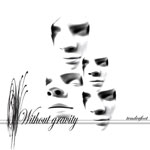 Without Gravity | Without Gravity - Tenderfoot (2004, One little Indian) The Tenderfoot boys have kept busy, steadily building a following, since 2002. They’ve earned a reputation for enchanting live shows, playing where ever and when ever in Reykjavík and out of Reykjavík. Tenderfoots' first cd is a great album with sweet music resembling Jeff Buckley, Nick Drake and bands in the "alt-country"-vain. Hurrah! (source: www.smekkleysa.net) (Roger Rey) |
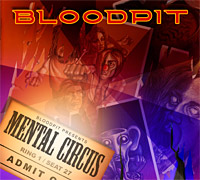 Bloodpit | Bloodpit - Mental Circus (2005, Playground Music) Here we have another sensational Finnish band! They are called BLOODPIT, and once again they play a very strong melodic mix of Goth, Glam and 70s groovy Hardrock riffs, ending up sounding like HIM, but still with an own sort of approach, which is very melodic. You might even call their ‘Mental circus’ CD a pure Melodic Rockalbum actually, because the songs are most of the time sounding like a melodic rockband. 11 songs are included and with the typical Northern European dark approach the songs sound modern and a bit moody, but still very melodic, especially during the choruses. I think the best description I can come up with here is a mix of GUNS’N’ROSES, HIM, TEN, BILLY IDOL and THE CULT. Lead singer/guitarist Matthau Mikojan has a good voice that sounds like a cross between DAVID BOWIE, AXL ROSE and the HIM singer, while the songs feature very melodic choruses (TEN, THE RASMUS, HIM style). There’s all sorts of songs on the album, uptempo, midtempo, semi-ballads, etc. although the band seems to be at their best during uptempo meloidic rockers such as “Bad echo”, “Bad-ass Blues”, “One more time” and “Out to find you”, but a semi-ballad like “Platitude” also sounds quite sensational. Definitely another highly recommended CD from Finland. (Source: Gabor Fabian, Strutter Magazine) (Roger Rey) |
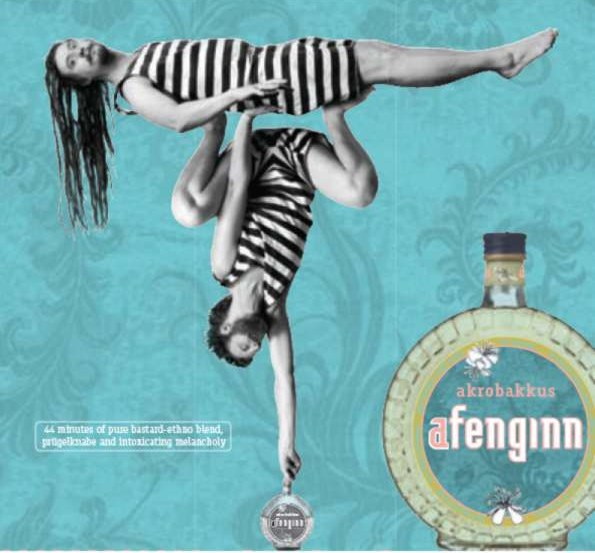 Afenginn | Afenginn - Akrobakkus (2006, Tutl) Well, it’s hardly a question of what is realistic, because when you’re entering the universe of Afenginn, reality looses its grip. More than being a neurotic escape, it must be seen as a parallel world stressing joy and spontaneity. The bands Finnish mandolin player Kim Nyberg puts it like this: “What we most of all have in common in this orchestra is that we can’t help loving eccentricity – and stand by it”. This odd eccentricity is a locomotive for composer Kim Nyberg in his search for new musical landscapes. Afenginns music is usually growing out of short stories from the parts of life where things are sloping, the ears are used for drinking and moose are emigrating. These stories are following each other like bubbles of madness and bliss, articulated mostly instrumental by the band. On the new release Akrobakkus Afenginn is using the bottle as container for its brand new extract of stories and music from the border districts. In Retrograd, Afenginns debut album, a moose was experiencing a place called Retrograd. In Akrobakkus the orchestra is distilling the honest and mad expression by using intoxication as the general idea/ main theme and that’s why the originally Croatian multi artist Zlatko Buric is contributing with his madness on one of the songs. “In Denmark it’s being said that you will hear the truth from children and drunkards. If that can be combined with some inspiration from the Antiquity and our unsalted mind flesh, we believe that it can affect people in today’s superficial everyday life”, declare clarinet player Rasmus thoughtfully. He continues: “We do not encourage wild and drunken revelry as at the roman bacchanals, but indeed to excessive consumption of our new album. Akrobakkus is the result of our fascination of the acrobatics of body movement and our inspiration from Bacchus, the Greek god representing ecstasy, vine and fertility”. However, a Nordic melancholy is at hand. Thus, the title is written in the old Nordic syntax for the voluptuous Greek god; Bakkus. Besides Rasmus and Kim the orchestra consist of drummer Rune, violin player Niels and legendary Aske Jacoby on bass. All of them educated and very skilled, this musical collectivity has been working its way up from its own unique path. The weird, wonderful and entertaining phenomenon has from the very start been the characteristics of Afenginn. Since entering the Copenhagen underground scene in 2002 the five bastards have distilled what they call their bastard-ethno: “Even though Retrograd was awarded World Album of the year 2005 we wouldn’t imitate a new style just to avoid repeating ourselves”, Rune joins in. “On the contrary we looked at things more introvert and Akrobakkus is a very honest album, I think. If you have enjoyed young bright rum in an intoxicating moment it’s natural to try a darker and older rum the next time. One of them that makes you feel good right out your extremities”, he adds laughing. (Source: www.afenginn.dk - Asger Olesen, april 2006) (Anita Steck) |
 Pólson Petur | Pólson Petur - Koma (2005, Tutl) Petur Pólson makes a remarkable reentry onto the faroese musicscene by the release of his first solo cd ‘Koma’. ‘Koma’ has a modern, international sound with musical inspiration from both faroese and international music. Stylewise we have modern rock with triphop influences - think Radiohead, Portishead and Sigur Rós. Petur not being the greatest of musicians himself, has found just the right partners in his band, to give life to his poetry extraordinaire. Lyrically we’re dealing with the very core issues in life. The texts touch very close to the essence of life’s fragile being and rather than ignoring and repressing life’s darker sides such as loneliness, deception, discouragement, alienation and rootlessness, Petur stares the fear in the eye and this makes this a remarkably practical cd. At light’s end It may seem as though we have a very depressing cd, but on the contrary. The title ‘Koma’ is a journey through darkness, culminating with Petur ‘coming’ to a lighter place in life. Thus the cd ends with the beautiful song ‘Koma’ written by Petur for his baby daughter Døgg. After hearing songs about the lows in life, it’s touching to hear Petur sing this song for his daughter. (Source: Jan Lamhauge Dimmalætting November 16th 2005) (Anita Steck) |
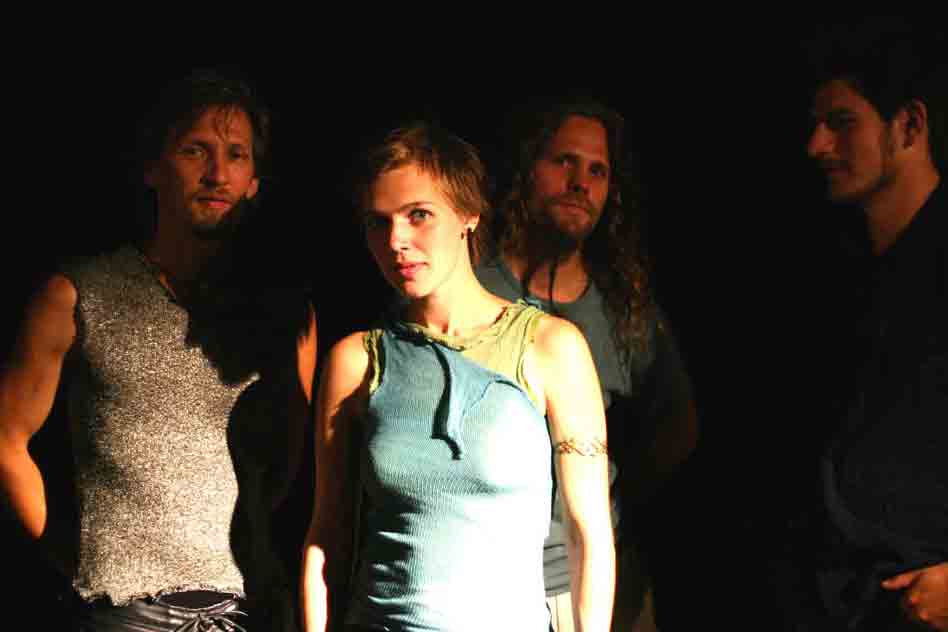 Valravn | Valravn - Krunk (2005, -) "If you know that a member of the technofolk band Sorten Muld is part of Valravn you might be surprised in first instance with this record. The sound of Valravn is in the first song very traditional, unpolished and raw. Thus very different from the tight produced electronic dance and ambient folk of Sorten Muld. Valravn sounds like a Faun who covers Hedningarna in a very convincing way or like an Omnia that knows something about traditional music. Still there are some songs on Krunk that feature modern electronic influences. This is both done very subtle like in ‘Drømte mig en drøm i nat’ but also more prominent with a dance beat in ‘Skovedanser’. Despite this all songs have a traditional Scandinavian touch, sometimes with a Pagan folk twist. This first cd by Valravn sounds convincing and leaves a taste for more. There is only one point of real approval and that is the singing. At times this could have been done better." 8 points out of 10 (Source: www.folkforum.nl - Martijn van Gessel, februar 2006) (Anita Steck) |
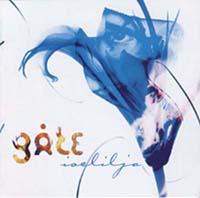 Gåte | Gåte - Iselilja (2004, Warner Music Norway) On the 18th of October 2004 Warner Music Norway released the follow-up to Norwegian quintet Gåte´s platinum selling debut album, Jygri (2002). The new album is titled Iselilja and is a refining of the sounds that made the first album a Spellemannprisen (Norwegian Grammy) winner. This means that Gåte stick to their dangerously effective amalgam of traditional folk melodies and powerful fuzzed up hard rock. Gåte is fronted by singer Gunnhild Sundli and it is her voice that grabs any listener, well versed in Norwegian traditional music or not. With her brother, Sveinung (fiddle, keyboards) and their three compatriots Gunnhild has successfully bridged the gap between the Hardanger fiddle driven Norwegian folk music and the somewhat more contemporary sounds of widescreen rock. --I wanted to make the sound of this album even more seamless, in the sense that I don’t want the listener to pinpoint what comes from the traditional sources and what is new. Kåre Christoffer Westrheim is the producer of Iselilja and a seasoned rock and jazz musician himself. His last production, the phenomenally successful album by folk-rock singer Odd Nordstoga, Luring (four time platinum award!) also blends traditional Norwegian folk sounds into contemporary settings. --What made me interested in working with Gåte was the realization that they are all really good musicians. Their potential is immense. With the breakthrough success of Jygri, Gåte hit the road with an authority that you rarely find among such young musicians. Their shows are spectacular events, much like making Hall of the Mountain King into a surround sounding laser lit rock club. Gåte's songs split themselves more or less evenly between real old traditionalism and songs based on contemporary lyrics written by poet Astrid Krog Halse. This time around Gåte also make the song «Kjærleik» («Love»), written by the leading Norwegian hardanger fiddle player Knut Buen, into a blistering piece of modern rock. Knut Buen, known to Norwegians as a serious gatekeeper on behalf of the traditional sounds of Norway, has wholeheartedly embraced Gåte and has on occasion joined them onstage, fully regaled in his Spelleman outfit. Much like what the hippie longhairs of Nitty Gritty Dirt Band experienced when they recorded Will The Circle Be Unbroken in 1972 with original country legends Mother Maybelle Carter, Roy Acuff and Earl Scruggs. After putting out their own independent EP in 2000, Gåte signed with Warner Music Norway and released their label debut, the commercially as well as critically successful Gåte EP in early 2002. That EP and Jygri were produced by Alex Møklebust, lead singer of art/ goth rockers Zeromancer. By this time the two Sundli siblings had assembled the line up that still makes Gåte; Magnus Børmark (guitars, synths), Martin Viktor Langlie (drums, percussion) and Gjermund Landrø (bass, vocals). --I think that the most distinct difference between this album and the debut, is the dynamics Gunnhild applies to her vocals. This time she brings it all the way down low as well. That makes the powerful vocal eruptions stand out even more, producer Vestrheim says. (Roger Rey) |
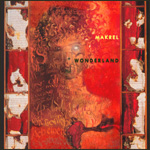 Makrel | Makrel - Wonderland (2004, Tutl) The Faroese band Makrel are back with their second album ”Wonderland”, after their somewhat fuzzy debut. It appears the band has found their own unique style. Makrel´s music is an unusual mix of catchy and melodic rock mixed with explosive and at times brutal elements. The contrast on ”Wonderland” is best illustrated with the song ”Walking Away”, which is melodic and relaxing, and followed by the powerful track ”Flashback Humour” which has an explosive chorus, this summarizes a lot of the songs on the album. What separates Makrel from a lot of other bands is their will and ability to be different. Lead singer Ári Rouch is without a doubt a voice which people will either love or hate, I myself, think he fits perfectly into the band´s melancholic, intimate and at times complaining expression. In addition there´s lead guitarist, Rasmus Rasmussen, who clearly must be familiar with bands like ‘Tool’ and ‘A Perfect Circle’ in additon to other great classic guitarists. This unique and blazing guitar really puts Makrel a few steps ahead of so many other rock bands. Concerning composition the band really has hit jackpot this time round. ”Wonderland” contains everything a rock audience could ask for, from easy catchy tunes like ”Walking Away” and ”Time is Now” to the more intense and thrilling songs like ”Imitations”, ”Flashback Humour” and the fantastic ”Differences”. It is a puzzle to me that this band has not been released outside the Faroe Islands, and a hint to the Danish record business to tighten up. The best rock album I have heard this year. (Roger Rey) |
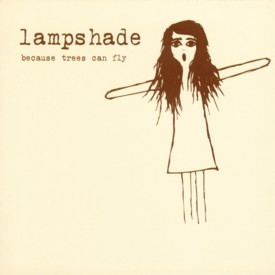 Lampshade | Lampshade - Because trees can fly (2004, Glitterhouse Records) Deep down in the Swedish woods in a small studio the Danish/Swedish indie band lampshade’s debut album came into existence. Massive and melancholic, sensitive and intense, beautiful and timid – this is the sound of the album ‘because trees can fly’ – the meeting of rebekkamaria’s fairy-like girlish voice and the instrumental universe of soundscapes. One moment it is marvellous and lyrically touching, the next it is taken by surprise with massive and loudly build crescendos like a roaring waterfall of noise. An album that is majestic like an autumn storm and at the same time gentle and beautiful like summer rain. The title ’because trees can fly’ is inspired by the poem ’Seglet blev brudt’ written by the Danish author Martin A. Hansen, and it is an expression of the band’s confident and simple but grandiose music. It is an album full of hope and positivism containing 12 songs that shape a whole of whispering lyric poetry and beautiful noise. The tracks are flavoured with trumpet, cello, horn, glockenspiel, piano and a lot of other musical details. The album is varied, but it has the deep leitmotif of presence and rebekkamaria’s characteristic voice in the centre. When singer rebekkamaria joined the one-year-old band lampshade in the late summer of 2001, a journey in sound and poetry began. A journey that rapidly took lampshade out on clubs all over Denmark, in papers, magazines, TV and radio. Not least of all it was a journey in music – music that made both the band and a swiftly increasing crowd of listeners excited. After the release of ‘adorable void?’ in March 2002, they played close to 100 concerts in Sweden, Germany, The Netherlands and Denmark, performed live at Danish radio – P3 (where ‘adorable void?’ and ‘adorable void? MOFUS remix’ was in rotation and ‘within symmetry’ was 8 weeks at Det Elektriske Barometer) etc. Moreover the band has performed on Danish and international compilation releases and also the Danish release ‘3P’ from Bird Hits Plane (3 EPs in 1 box including the bands Kvæg, lampshade and Apartment). lampshade, has managed to address both the so-called underground and a broad mainstream audience in Northern Europe. The band writes all its songs together and all contribute with new ideas and ‘relics’ of each of their musical raising that roughly looks like this: Guitarist Martin has his background in hardcore and melancholic rock (e.g. Rage Against The Mashine, Blindside, Smashing Pumpkins, This Beautiful Mess, Radiohead), while the Swedish Drummer Daniel is into emorock (e.g. Sunny Day Real Estate, Misprint, Jimmy Eat World and Last Days Of April). The musical revolution in bassist and singer Johannes’ life came with noise- and postrock (e.g. Mogwai, Do Make Say Think, Glorybox). Lead singer and key-player rebekkamaria’s universe is full of lo-fi rock and singer/song-writer music (e.g. Stina Nordenstam, Low, Damien Jurado, Rosie Thomas, Danielson Family and Spokane). (Roger Rey) |
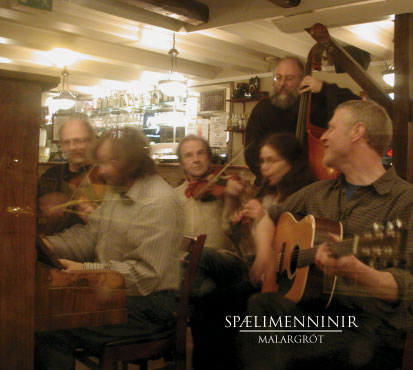 Spaelimenninir | Spaelimenninir - Malargrót (2003, Tutl) Put all the tracks from this stately and cheerful traditional dance album into a blender and what do you get? Denmark with a little Shetland spice! But there's no electric mixing appliance here, and no Shetland...it's the piano that is reminiscent of Shetland.... Spaelimennir is a multi-national Scandinavian dance band, with members coming from Denmark, Sweden, America (including grammy winning record restorer Charlie Piltzer on bass), and the Faeroe Islands, but it is to the small, isolated Danish Faeroes that they are most closely linked. How do you get to the Faeroes? If you take the Atlantic ferry north from Shetland to Iceland in the summer, you will find them. The band collects music from The Faroe Islands, and you will find a few of these tunes on Malargrot. There are other tunes from Norway, Sweden and Denmark, and some are composed by band members. The dance music on the instrumental Malargrot is light and cheerful, and very well performed. There are no shamans or omens here, little dark mystisk, but rather community and laughter in warm houses, pubs, and halls. But my favorites do have a little dark lilt in the key structure. One is "Fair Isle Reinlendari," composed in Scandinavian by frettist Ivar Barentsen for the island between Orkney and Shetland...a wee troll seems to be singing in this one, so it sounds a bit Danish and Medieval. The second is a set of tunes from Fano in Denmark, the last of which, "Det forst brujstyk," contains a powerful minor passage emphasized here by piano. Two Fareoese tunes are from the notebook of Jens Christian Svabo (1746-1824). The first, between two Barentson compositions, is straightforward and light; the second, Mars, is an orderly tune that sounds like Bach.! Faroese Kristian Blak's (mostly) solo piano compositions contrast with the rest of the album tracks. They are actually arrangements of northern traditional music, but, with jazz influences, are much more stark and modern than the originals, and slower and less happy than the dance band tunes. Perhaps it is a contrast with the modern and the historical, with modern autonomy and historical community, or perhaps it can just be heard that way. Recommended for anyone interested in European/Scandinavian music, dance music, or folk music in general. Malargrot is a lovely album with spirit, and good, honest arrangements and production. (Roger Rey) |